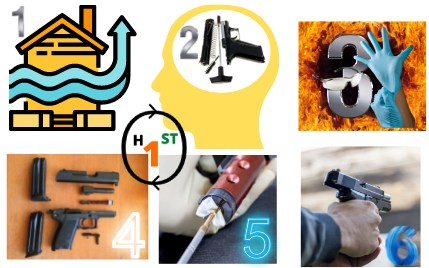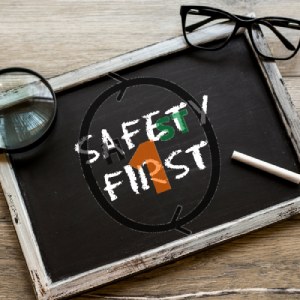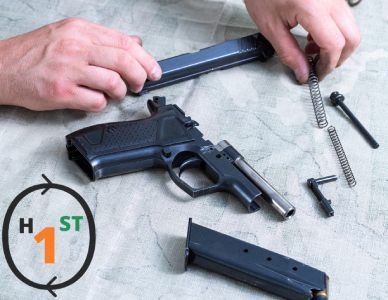Welcome to the group. All veterans have been where you are now. and most veterans had a mentor to answer those little questions and make a fool of themselves. I remember asking if I needed to lubricate the trigger, and my grandfather laughed. But nowadays you won’t need to make a fool of yourself by asking stupid questions. Because we have the internet!
Having a mentor has benefits, but sometimes self-teaching can give you in-depth knowledge which can not be achieved by learning from someone else. It can be dangerous! if you don’t follow some basic safety rules. This article will help you understand the question “How to Clean A Gun?”, and not just answer it. After you have read this you will know how to clean any gun, even if you have lost the instructions. It’s not rocket science but you need to be careful.
This article will try to address all those minute and neglected questions any new gun owner may have while cleaning. Not just “do this then that” but why do this instead of that and why follow a certain untold order of doing things. I believe even veterans will appreciate all the information compiled in one place.
Before you begin, if you are new to firearms then you must familiarize yourself with the cleaning tools because we will be using the names of the tools in this article.
The 6 Major Steps
In this article, I’ve sectioned the whole cleaning process of any firearm into 6 major parts, while section 5 has a few sub-sections within itself.

I’ll provide justification on why I clean a firearm the way I do it. And maybe you will be able to modify my methods to clean your firearm more effectively and quickly. But if you are looking for specific gun-related instruction, sorry – maybe YouTube is a better option for that. But they will force the instruction down for you to follow.
1. Preparing the Cleaning Environment.
We clean the firearm of dust, lead particles, carbon residues using solvents. In most cases, the dust and lead particles do not contaminate the air. But the cleaning solvent and gun oil can evaporate and create a foul smell in the room. These solvents are also flammable and can be fatal if inhaled in large quantities.
To avoid these problems, it is advised to clean your firearm in a well-ventilated area having a good airflow with enough light to see the narrow spaces of the guns. The airflow should be downstream from you flowing out the room into the open. This minimizes inhaling those toxic gases.
I’ve few friends and seen a lot of YouTubers who switch “ON” the air conditioner and do it in a closed room. And even after reading the labels on the cleaning solvent and gun oil if they do that, then I think they take more risk than they have to.

Ideally, I would do it outside under a shade before lunch to clean my firearm, but situations may arise (rain or snow), or leaving in an apartment can put some limitations. So I opt to sit near a window with a table lamp for proper lighting and airflow. However, you achieve the airflow or lighting is up to you but those are the only conditions you must meet.
2. Safety First
Since you will likely not have a mentor, read this section very carefully and try to remember them.
- Inform members of the family that you are going to clean your gun – because it’s better to avoid any distractions and finish cleaning in one sitting.
- Avoid cleaning your gun in the kitchen or near any fire ignition, as flammable components in the cleaning solvent may lead to a fire.
- Wear safety glasses coz the solvents or springs in your firearm can harm your eyes.
- Gloves are also advised if you have any allergic reaction to cleaning solvent or lubricant.

- Remove the magazine and chamber of any live rounds – You do not want to accidentally shoot something you do not want to destroy.
- Double-check the magazine and chamber for live rounds. Do a triple check if you are not sure.
- Remove gun powder or live rounds from the room, because in case a fire does occur, you will need undivided attention on how to suppress the fire and not worry about random bullet firing.
3. Getting into the mindset.
Simple but a difficult task, just mentally preparing yourself. It’s not time-consuming but you should not do it in a hurry. As you do it again and again you become an expert with your weapon and make clumsy mistakes while taking shortcuts, Avoid shortcuts and clumsiness at all costs.
Know that you have to clean and clean properly.

4. Disassemble your firearm.
Each firearm has a defined set of rules on how to disassemble it. Read the instructions carefully and follow them. Like I mentioned earlier this article is not for a specific firearm, but a general one for all.
Any firearm will have a few small parts and it can be easily misplaced if not carefully placed. So before disassembling your firearm, ready a surface using an old newspaper, towel, or rubber mat and small containers to keep everything in place and avoid spilling the cleaning solvent or gun oil on the tabletop.
Usually, you do not need to disassemble the whole firearm. Only the parts that get used while shooting. Like the barrel, chamber, Slide (in case of a handgun), and occasionally the recoil spring.

But you should fully clean your gun at least once in 4 months if you have do not use it regularly.
5. Cleaning & Lubricating your firearm
Back in the days of black powders, there were too many residues along with the smoke that would clog the chamber and cause malfunction with the ejection mechanism of the firearm, jamming the firearm in times of need. Check this youtube video to see the difference in the smoke created. Ohh, the black powder does have a nice smell to it.
But with the invention of smokeless powder, the amount of residue decreased along with the smoke, increasing the performance of the gun and shortening gun cleaning time. But the smokeless powder has not eliminated the problem altogether, which is why we need to clean our firearm occasionally to keep it in top performance.
While firing most of the exploded gas fills the barrel and pushes the projectile out the muzzle hence the barrel receives most of the powder residues, and since the burnt powder residue is still loose it gets into the chamber while ejecting the empty case and repositioning a live round. With continuous firing, the burnt powder residue slowly makes it into other parts of the gun from the chamber. Such as the firing pin mechanism (spring, safety), slides (in case of handgun), trigger mechanism, and rarely the magazine.
Most of the parts of the gun are easily accessible except the barrel, and that is where you should always begin during your cleaning session.
Gun Barrel Cleaning (Part 1).
In most of the gun cleaning kits, you will have about 6 to 10 tools just to clean the barrel. That is because it has the toughest of powder residues that did not get blown away even with that extreme pressure during firing. So to clean our barrel our first step is to loosen those tough residues using the cleaning solvent and 2-5 more items.
- Cleaning Rod
- Cleaning Solvent
- Gun Oil
- Slotted tips / jags
- Cotton Patches
- Muzzle Guard
- Cotton bore brush
- Bronze bore brush
- Bore Light
- First, scrub inside the barrel using the bronze bore brush thoroughly.
- Then either use a cotton bore brush or cotton patches to apply the cleaning solvent inside the barrel.
- If you are using cotton bore brush simply wet the cotton brush with cleaning solvent and insert it inside the barrel from the breech end of the barrel.
- Or place a cotton patch wet with cleaning solvent rapped around jags or slotten tips and insert it in the barrel from the breech end.
- Slowly push the wet cotton patch from the breech to muzzle end. You will notice lots of residue on your cotton patch when it comes out of the muzzle end.
- If you used a cotton bore brush then you should be fine with one travel because of the surface area the bore brush covers,
- but if you used patches go another round with a fresh side of the patch.
- Now take the phosphorous bore brush again and give the insides of the barrel a good scrub.
- Leave it aside to soak and loosen those tough burnt powder residues
Did you notice I bolded the breech end? That’s because if you clean the barrel from the muzzle end then there is a higher chance you will damage the crown of the firearm, which decreases the accuracy of the firearm. The breech end is where the chamber meets the barrel. But if you must clean your gun from the muzzle end, then always use a muzzle guard (some call it bore guide), it protects the firearm’s muzzle from the wear and tears caused by the cleaning rod.
Bullet Chamber
Cleaning the bullet chamber is simple. Begin by brushing with the chamber with an All-purpose brush or white bristle toothbrush, use white bristle to better understand when to change the brush itself. Use a smaller brush to reach tough spots and corners. And keep at least 3 brushes for the chamber cleaning.
But with brushes alone, the chamber will not be shiny clean. To achieve the shiny chamber use cotton patches slightly wet in cleaning solvent and rub the bullet chamber surfaces.
If you have an old blunt toothbrush, then wrap an old toothbrush with a cotton patch or microfiber cloth to clean the chamber. It is fast and easy to use than your fingers. Finally, take another dry cotton cleaning patch to clean the excess cleaning solvent.
Do a self-test, take a cotton swab, and test for the presence of cleaning solvent in the bullet chamber.
And always remember “Never lube your chamber“! Why?
Firing Pin Mechanism
The firing mechanism and safety switch are usually related and in my Honest Opinion, should be considered as one when cleaning the firearm. Usually, they are very far from where the bulk of the burnt powder residues are, which means rarely any residues come in contact with this mechanism. Hence, it barely requires any extensive cleaning, but you must clean them eventually depending on the use of your firearm.
Just like cleaning the chamber, you begin with brushing the mechanism, clean them using cleaning solvent & finally wipe them off the cleaning solvent. And use very little gun oil on the springs and moving parts.
But never lube part of the firing pin that stricks the primer. Why?
Trigger Mechanism
It’s finally time for me to disclose what my grandfather replied to my naive question, “lube the parts that move, but not the parts that are exposed”. Maybe not in those exact words (it has been a while you know).
The trigger mechanism should be brushed, wiped, and with a dry patch remove the cleaning solvent, then with just 1 drop of gun oil on a cotton patch gently rub the spring and the moving parts. If the cotton patch you used for oiling the trigger mechanism is not dirty then you can use the same patch without that 1 drop of gun oil.
Slide (in Case of a Handgun) – Part 1
The slides must have been already disassembled at this point. Not much to clean here, brush, wipe and dry. But slides require some extra care, the rails gather dust and residues, and it’s hard to reach with a finger.
That’s where the picks come in, I personally like the bent pick over the straight pick. Use them to reach the tough corners and pick those residues.
After that stand it upright and place 1 drop of gun oil on each rail and place it aside in an upright position and let gravity pull that drop of gun oil down the rail.
Gun Barrel Cleaning Part 2
By now it should be soaked enough to loosen those tough stains. So begin by scrubbing the insides of the barrel with a phosphorous bronze bore brush. The next step is to clean the bore, and this can be performed using 3 different tools, Cotton Bore Brush, Jag, or slotted tips covered in cotton patches.
Screw any one of the 3 tools on a cleaning rod or flex cable and push it in the barrel. Personally, I avoid using the cotton bore brush because I’ll need to wash it, instead, I prefer using cotton patches because those are disposable and do not harm nature.
I’m a lazy guy, so I do things the easy and cheap way. In my method of bore cleaning, I use slotted tips and cotton patches manufactured by Otis technology. The way the cotton patches are designed enables me to use a single patch up to 6 times helping me carry less when I’m field cleaning. With jags, you can use any type of cotton patch only 2 times. Meaning you will need to carry more for the same work.
Run the cotton patches in one direction only. And always use the clean side every time and that should do the trick. The Final Step is to use a bore light to visually inspect the inside of the bore and judge how clean it is. If you notice some rough texture, then you will need to clean more.
Now lube it the same way you just cleaned it with 1 or 2 drops of gun oil on a fresh cotton patch, but this time run the same cotton patch a few more times to evenly spread the gun oil. There should only be a light coating, if you feel it’s too much, then run a dry patch to remove that extra oil off.
Lubrication helps bore from rusting, Careful not to oil excessively because it will help dust cling on. But in case it was over oiled, then just run a dry patch and that should do the trick.
Slide Part 2
By now gravity must have done its work and pulled that one drop of gun oil all the way down so wipe it down with a cotton patch or a q-tip.
6. Reassemble & Testing the Firearm.
Like I mentioned before, follow the instruction specifically for your firearm and reassemble the firearm.
Finally, to check if you have reassembled the gun properly or have excess lube anywhere we need to test the firearm. It’s simple, load your firearm without bullet and blank fire, listen for the click sound. If everything is reassembled correctly, you should get only one click sound.
Do You Know How to Clean a Gun?
The answer should be yes. Because you have invested time to absorb the information in this article.
In summary, you need a well-ventilated area with good lighting, prepare mentally and care for your safety, disassemble the firearm, Clean – inspect – lube and finally reassemble and test. The whole process should take you less than 20 minutes, but it can increase if you have a heavily tarnished rifle or handgun.
Please keep in mind that you do not need to clean the firing & trigger mechanism after every shooting session. But I would advise cleaning all components when the gun will not be used for a long time or have not been used for a long time.
Scenarios:
Scenario 1: You are on a hunt with friends or colleagues.
If you have managed yourself a cozy hotel room where you will come back after a whole day of shooting then the cleaning procedure mentioned above is acceptable.
But if you are in the jungle camping with fire and tent then and total disassembling of the firearm is not feasible. Then use a bore cleaner or portable cleaning kit to get the cleaning job completed quickly. But keep in mind that bore snake cleaning quality will never match the quality of extensive cleaning.
Scenario 2: You are in competition.
Absolute performance and accuracy are a must for each shot. So in between shots, you can use a bore snake to clean your firearm with minimal field stripping the firearm for maximum accuracy.
FAQ
Why not use a bore snake instead.
You can use a bore snake but the cleaning quality is not what you would get from total cleaning.
Can I use household items for gun cleaning?
Cleaning a gun using household items is possible but it’s like driving a car with flat tires. I would recommend using caliber specific cleaning kit if you own only one firearm but if you own multiple firearms, then those “Universal Gun Cleaning Kit” may be a better option. You will also need some consumable items like cleaning solvent, cotton patches, Cotton Swabs & Gun oil for lubrication.
Should I lube the bullet Chamber?
No! Never! Because gun oil (Lubrication) is not compressible, due to that it generates more pressure in the bullet chamber while firing, which can split the case mouth and also lengthen the case which causes case extraction malfunctioning. Another problem lube in the chamber creates is the case grip on the chamber is reduced which distorts the fired projectile and reduces accuracy.
Should I lube the firing pin?
Firing pin specifically – don’t lube it. Because it will collect dust over time and finally not hit the primer hard enough to ignite the gun powder.
But you can use lube on the spring and some moving parts of the firing pin assembly. Take a cotton patch, place 1 drop of gun oil on the cotton patch, let it spread, and then use that one patch to lube the whole firing mechanism.
Can I use an ultrasonic cleaner to clean my firearm?
Ultrasonic Cleaner is an excellent firearm cleaner it removes the burnt powder residue and the lubrication thoroughly. So you will need to lubricate everything properly. And never use an ultrasonic cleaner to clean aluminum, wood, or polymer, you will just reduce the longevity of your firearm. Check more about ultrasonic cleaners here.
